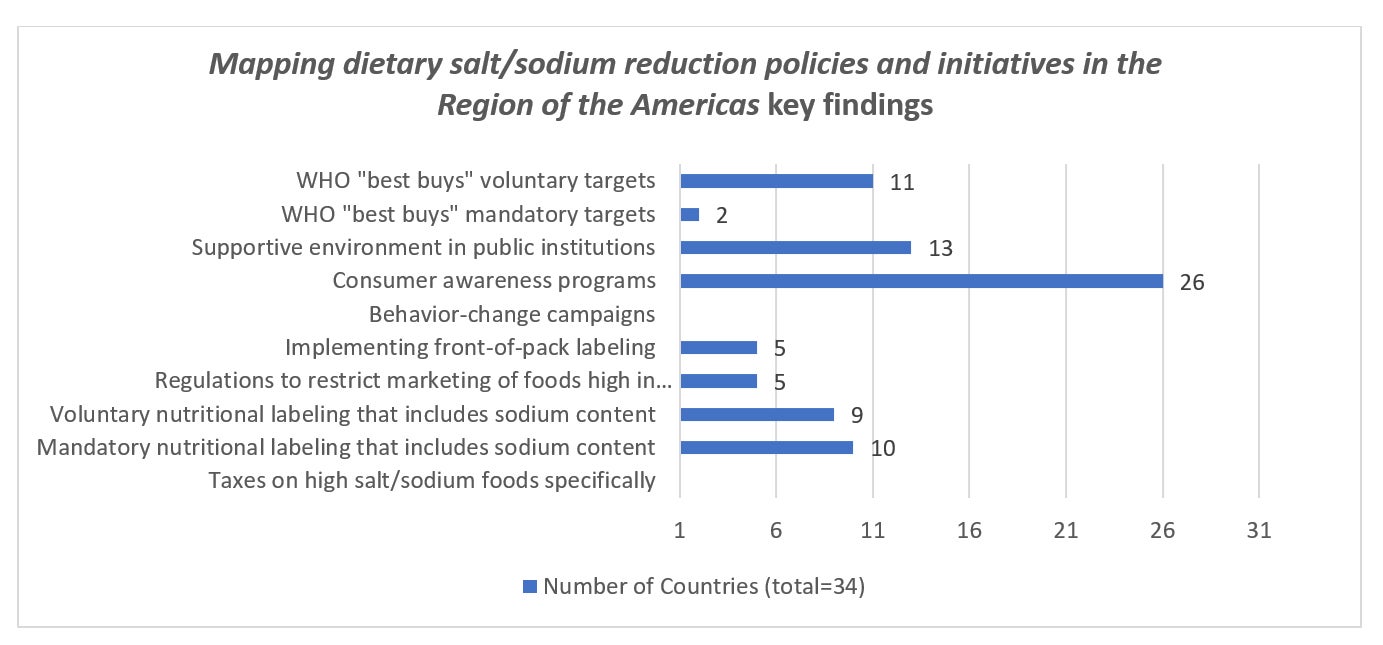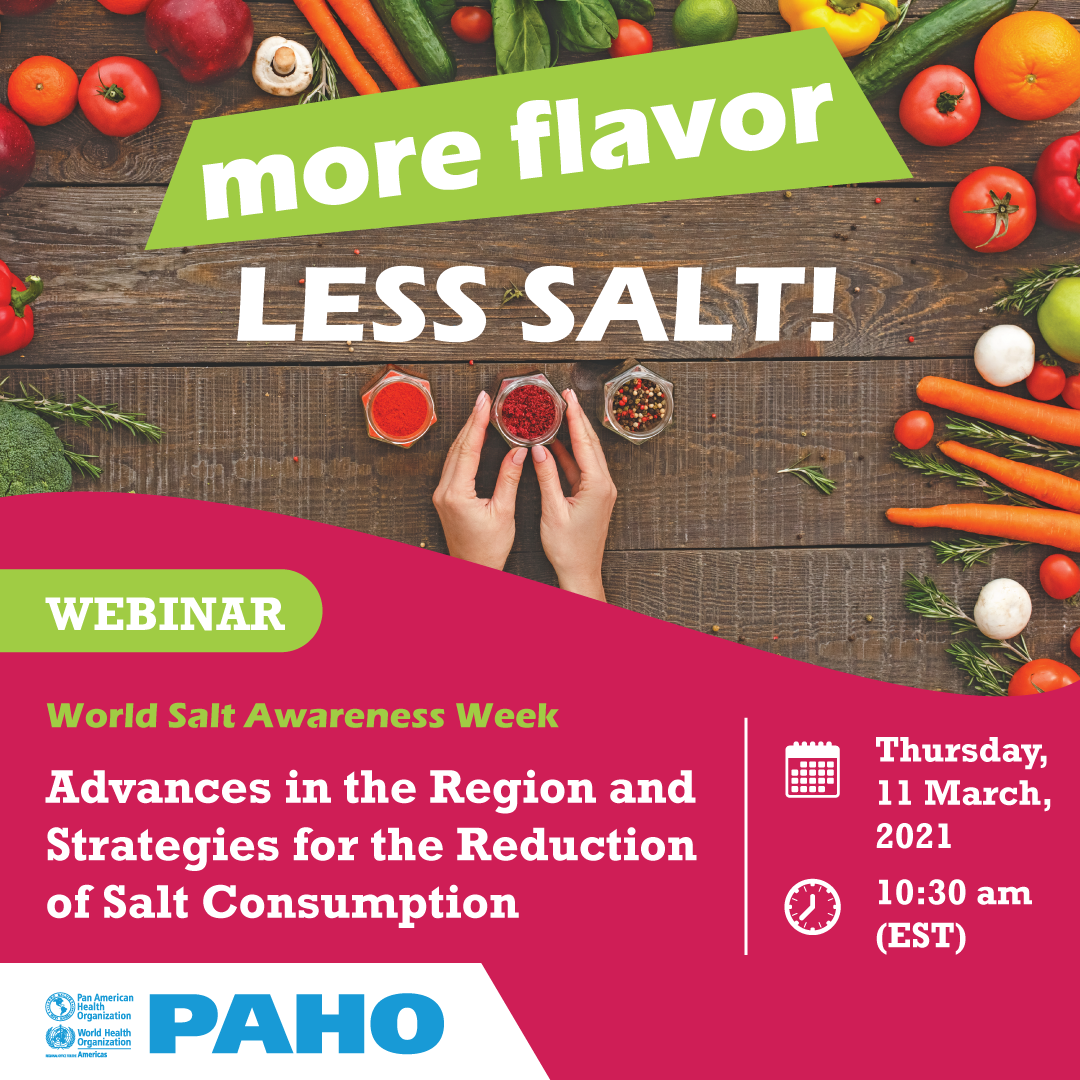
Washington, DC. March 10, 2021 (PAHO) - Heart disease has remained the leading cause of death globally for the last 20 years. In the Americas , approximately 1.1 million people lost their lives in 2019 alone due to ischemic or coronary heart disease, with high blood pressure as the leading risk factor for cardiovascular disease (more specifically, CVD morbidity, mortality and disability).
One effective way to tackle heart disease is by reducing the amount of salt people consume, as this decreases negative effects on blood pressure.
To boost cardiovascular health in the Americas, the Pan American Health Organization (PAHO) has proposed a 30% relative reduction in the average daily salt and sodium intake as a means to achieve a target of salt intake below 5 grams per day - equivalent to 2 grams of sodium - by 2025. The organization's Member States have also agreed on a voluntary global target by 2025 to cut the prevalence of raised blood pressure by 25% relative to its value in 2010 (target 3.4 of the 2030 Sustainable Development Goals or SDGs [ 1] ).
Working together to achieve national and regional salt consumption targets by 2025
Countries in the Americas are implementing strategies so that people can reduce the risks of excessive salt intake and promote healthier habits. To keep track of their policies and initiatives focused on dietary salt reduction, PAHO created an interactive tool that policymakers and other actors can use to measure and compare progress toward reaching national and regional targets.
The research behind this tool shows that there have been important accomplishments in the promotion of policies to reduce salt consumption in the Americas, but the level of implementation is difficult to assess and differs considerably by country. One key finding is that a further call to action is needed for governments to scale up regional efforts.
Implementation and evaluation research are still needed in the Region to assess and improve regulations, policies, programs, and public health measures aimed at reducing salt intake.
The interactive tool allows the monitoring of existing policies and initiatives, identifies gaps according to WHO’s “best buys” or cost-effective public health measures to prevent and control diet-related noncommunicable diseases (NCDs), keeps track of these public health measures and provides information to prioritize actions for future work.
Data and information to guide effective policies that help people improve their health
To build the Salt Intake Reduction Policy Mapping Tool, PAHO consulted with health ministries and reviewed information about the general and specific objectives of national policies and public health measures in 34 countries, including legislation and regulations in line with WHO´s “best buys” and relevant reports on surveillance and monitoring. Based on this information, PAHO shared recommendations based on policy implementation and progress in achieving the targets, acknowledging that each country has a different reality.
PAHO found that 70% of the countries in the Americas included at least one recommendation to reduce salt intake in policies related to the control and prevention of NCDs but only six countries have a specific and comprehensive national policy that includes at least three of the four WHO´s “best buys.” Argentina is the only country with a national sodium reduction law. None of the countries included in the study have applied national behavior-change campaigns at the national level that apply a robust social marketing approach.
Health ministries can use the Salt Intake Reduction Policy Mapping Tool to learn about policies and regulations that were implemented in other countries and follow their progress. For example, countries that are at the earliest stages of implementation and can learn from more advanced efforts. Likewise, Government agencies, legislators and other decision-makers that are not directly focused on public health can understand more about salt reduction strategies to find paths for more comprehensive cross-sectoral strategies.
PAHO is also using the tool to gather valuable information about the policy gaps and challenges that countries in the Americas are facing to offer them the technical cooperation they need for more solid strategies to protect their populations. The four WHO’s “best buys” have greater impact on salt reduction when implemented simultaneously, and countries in the Americas and PAHO can collaborate to generate a healthier environment for this to happen.
The tool is helpful for governments but also for other actors interested in supporting efforts toward reducing salt intake, such as civil society. Transparency can protect consumers through cost-effective and cost-saving strategies to benefit both public and other actors.
Reducing the population’s intake of salt by 30% and creating the conditions, incentives and public health environment to favor regional and global targets by 2025 will help improve people’s wellbeing and save lives. However, data show that countries in the Region should accelerate its efforts to achieve this vision. Comprehensive and crosscutting efforts will be extremely valuable to this end, and the Salt Intake Reduction Policy Mapping Tool can offer solid data and information to build better strategies and scale-up efforts.
[1] Aligned with WHO Global Action Plan on NCDs 2013-2020, the PAHO Plan of Action for the Prevention and Control of NCDs 2013-2019 has proposed a 30% relative reduction in the mean salt / sodium intake in the population, with the aim of achieving a target of salt intake per person fewer than 5 grams per day (2 grams of sodium) by 2025. Member States have also agreed on a voluntary global NCD target for a 25% reduction in the prevalence of raised blood pressure (defined as systolic blood pressure ≥140 mmHg and / or diastolic blood pressure ≥ 90 mmHg) relative to its value in 2010, by 2025.
From March 8 to 14, PAHO observes the 2021 Salt Awareness Week: “More flavor, less salt!”
Webinar
- DATE: Thursday, 11 March, 2021
- TIME 10:30 am- 12:00 pm (EST)
- REGISTER: https://paho-org.zoom.us/webinar/register/WN_9OjKnQpST-uh7AQner3pyQ






